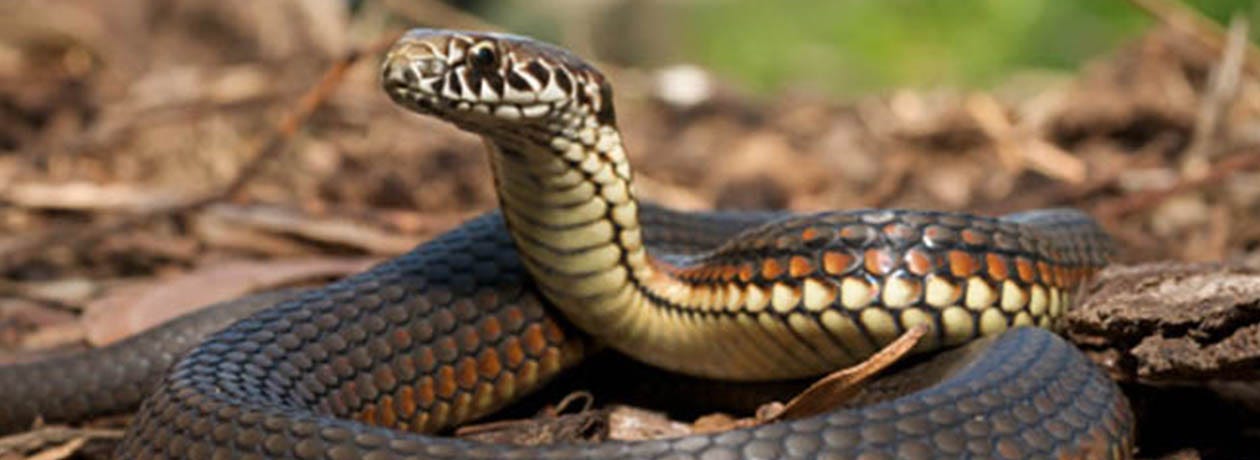How to ID & Get Rid of Snakes

When your customers come to you about snake problems – maybe they spotted one in the garden, woodpile, or even outside a business – the first question they will want answered is whether it’s poisonous. The second question—regardless of the answer to the first—is how to get it to go away.
Good news: You (or your customers) don’t have to be an expert to answer either of those questions.
Four Venemous Snakes
In North America, only four types of snakes that are venomous. (Note that snakes are venomous, not poisonous.)
Cottonmouths are dark in color, from green to black, with vertical dark lines by each nostril.
Locations: Cottonmouths are frequently found near water, swamps, irrigation ditches and other soggy areas. They are most abundant in the southeastern and southwestern United States.
Bites: A bite causes immediate, intense pain that is accompanied by bleeding, swelling, and muscle weakness. Loss of muscle function and even paralysis can follow.
Copperheads have bodies that range from brown to bright orange and even peachy, but their heads are almost always a light brown or orange. Young ones typically have yellow tails.
Locations: They are found in rocky areas near swamps, ponds and streams. Copperheads can be found from Florida to Massachusetts and as far west as Nebraska.
Bites: Most years, copperheads account for more bites of people than the other venomous North American species, but they also have the mildest venom, so those bites are almost never lethal. Pain and swelling start quickly around a copperhead bite and spread out to the limbs. Numbness, nausea, and a rapid pulse may follow.
Rattlesnakes have thick bodies with skin that has dark geometric patterns on a lighter background. They are the easiest snake to identify because they have a distinctive “rattle” at the end of their tails that they shake when threatened.
Locations: There are 16 species of rattlesnakes in the United States, and at least one of them can be found in every state.
Bites: Rattlesnake bites are painful and produce such symptoms as swelling of the whole body, labored breathing, blurred vision, a rapid pulse, and even paralysis.
Coral snakes are the most colorful of the venomous snakes, with bands of red, yellow, white and black wrapping around their bodies. The colors are the focus of a popular rhyme that’s used to distinguish them from similar-looking species, particularly the harmless king snake: “Red touching yellow will kill a fellow. Red touching black, you’re OK, Jack!”
Locations: Coral snakes spend most of their time in burrows under rocks or in piles of rotting leaves. You’re most likely to encounter them in the southeastern and southwestern United States.
Bites: Coral snake bites may not cause immediate pain, but within an hour or two, they can result in slurred speech, drowsiness, weakness, difficulty swallowing, and convulsions.
Common Traits
A few characteristics shared by venomous snakes can help with quick identification:
- Head shape: Most snakes have round, spoon-shaped heads that are no wider than the rest of their bodies. The dangerous species have venom sacks on their heads, giving them an easily recognizable triangular-shaped head that flares out from their torsos.
- Eye shape: The pupils of harmless snakes are round, like yours. All four types of venomous snakes have elliptical pupils, which appear like slits somewhat akin to those of cats.
- Body type: The vast majority of snakes encountered in the U.S. and Canada are small, thin, and rounded like a pencil. The venomous types are thicker and more muscular, and they grow to more than 2 feet long. The biggest, the eastern diamondback rattlesnake, can be up to 6 feet long and weigh up to 10 pounds.
- Heat pits: The venomous pit vipers (cottonmouths, copperheads, and rattlesnakes) each have small but visible “pits,” or depressions, on their heads between their nostrils and their eyes. They use these as heat sensors that help them find and track prey. Other types of snakes do not have these pits.
- Surface swimmers: Many snakes swim in freshwater lakes, ponds, and creeks, but cottonmouths are the only venomous type you’ll encounter in water. When harmless snakes swim, only their heads are visible as they move. Cottonmouths (also called water moccasins) are able to hold their whole bodies on the surface of the water as they swim.
How to Get Rid of Snakes
Snakes tend to be wary creatures that avoid exposure, though they do sometimes warm their cold-blooded bodies on rocks and other surfaces that heat up on sunny days. Your customers are most likely to come across a snake in uncultivated areas of a property and around good snake shelters, such as piles of firewood, rocks or brush.
Advise your customers to follow these steps to get rid of snakes.
- Remove food. The primary reason snakes encounter humans is because they’ve found easy access to prey. With that in mind, use traps and repellents to eliminate mice and other small mammals. Also, clean up bird seed, pet food, and other rodent attractions.
- Eliminate shelter. Snakes need undisturbed places to hide. Mow areas where grass and weeds grow tall and clean up piles of debris around a property. Snakes also make use of burrows dug by other animals, so fill those spaces should be filled.
- Use a repellent. Snakes have a sensory device known as a Jacobson’s organ that detects pheromones and other subtle chemical cues from their environments. Snakes flick their tongues to pull in those cues for their Jacobson’s organ to interpret. Effective snake repellent products, including those available from Victor® (effective against rattlesnakes and garter snakes only), disrupt this function and drive off snakes in search of more comfortable conditions.
